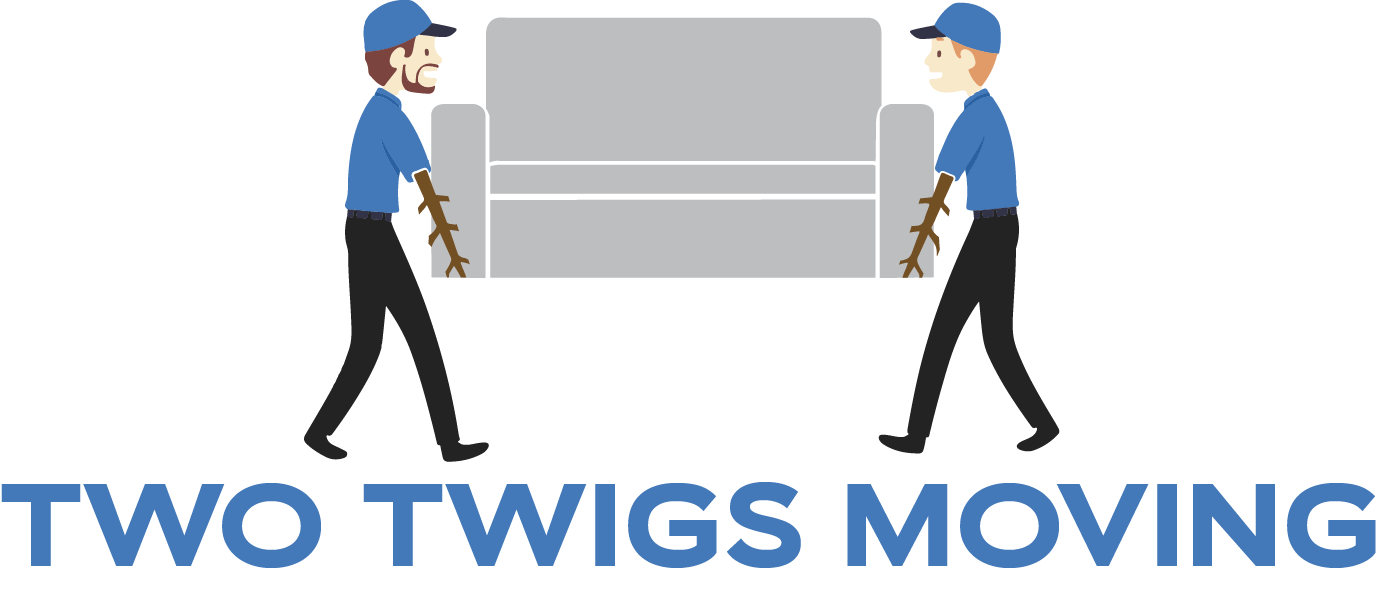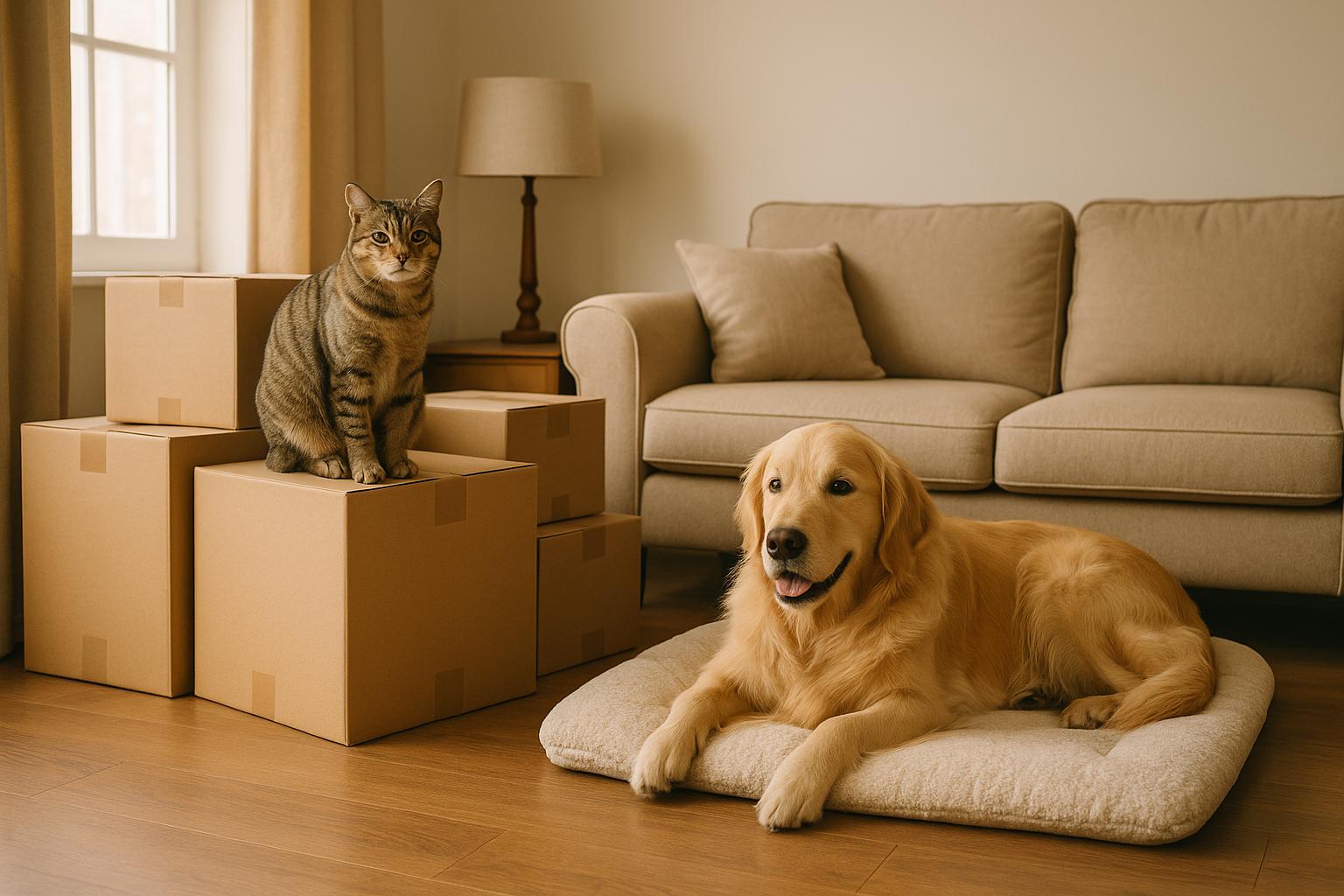Relocating with pets can be stressful, but you can make the process easier for them with the right approach. Here’s what you need to know:
- Understand their stress: Pets thrive on routine and familiarity, so moving disrupts their comfort zone. Watch for signs like pacing, hiding, or changes in eating habits.
- Prepare early: Introduce moving boxes and carriers weeks before the move. Stick to their daily routines and create a safe space with familiar items like their bed or toys.
- Update identification: Ensure their ID tags and microchip information are current with your new address. Keep vaccination and medical records handy.
- Pack a travel kit: Include food, water, medications, comfort items, and essential documents for the first 24–48 hours.
- Keep them safe on moving day: Confine them to a quiet room or leave them with a sitter to avoid chaos and escape risks.
- Help them adjust: Set up a familiar “home base” in the new home and introduce them to the space gradually.
Professional movers can handle the logistics, letting you focus on your pet’s well-being. By planning ahead and staying calm, you can make the move smoother for everyone.
How Moving Affects Your Pet
Understanding why your pet feels anxious during a move is the first step to helping them through it. Unlike us, pets can’t rationalize the changes happening around them. For them, moving feels like their entire world has been turned upside down.
Why Pets Get Stressed During Moves
Pets thrive on routine and familiarity, so a move can be a huge disruption. Their sense of security comes from familiar scents, routines, and their established territory. When you pack up and relocate, they lose these comforts all at once.
Territorial animals like cats and dogs create their domain through scent markers, favorite napping spots, and well-worn paths in your home. Packing up your belongings and emptying rooms erases these markers, leaving them confused and unsettled. The sudden introduction of new sounds – like tape ripping or bubble wrap crinkling – only adds to their unease.
Research published in Scientific Reports highlights that "Dogs, to a great extent, mirror the stress level of their owners". If you’re feeling overwhelmed by the move, your pet will likely pick up on it, creating a stressful feedback loop for both of you.
New surroundings present yet another hurdle. Unfamiliar smells, sounds, and layouts can overwhelm pets who rely heavily on their senses to feel secure. Even the trip to your new home – whether it’s a short drive or a long journey – can expose them to strange sights, noises, and motion, triggering anxiety.
Signs Your Pet Is Stressed
Spotting stress early can make a big difference for your pet’s well-being. Recognizing the signs means you can step in before their anxiety worsens. A 2022 study found that dogs adapted better to new surroundings over time, emphasizing the importance of addressing stress symptoms promptly.
Physical signs are often the easiest to notice. Dogs might pace, tremble, or pant excessively even when it’s not hot. They may lick their lips repeatedly, drool more than usual, or show the whites of their eyes. Look for body language changes like ears pulled back, a tucked tail, or a stiff posture. Behavioral shifts, such as increased barking, whining, or withdrawal, are also common.
Cats and dogs express stress differently. Dogs might bark or howl without clear reasons, while cats may growl, meow excessively, or become unusually quiet. Some pets may hide in unusual places like under furniture or inside closets, while others might cling to you more than usual.
Changes in eating and bathroom habits are also key indicators. A stressed pet might refuse their favorite treats, skip meals, or eat frantically. House-trained dogs may have accidents indoors, and cats might avoid their litter box. Digestive issues like vomiting or diarrhea can also occur.
Here’s a quick comparison of stress signs in dogs and cats:
| Stress Signs in Dogs | Stress Signs in Cats |
|---|---|
| Excessive panting or drooling | Hiding in tight spaces |
| Pacing and restlessness | Flattened ears and tucked whiskers |
| Cowering with ears back | Dilated pupils and hypervigilance |
| Refusing food or treats | Unusual vocalization or silence |
| Indoor accidents | Avoiding the litter box |
| Chewing or scratching destructively | Aggressive reactions to touch |
Separation anxiety can also spike during a move. Pets may become overly clingy or panic when left alone. Dog trainer Sally Grottini explains, "Extreme stress or anxiety like this may require prescribed medication". If your pet stops eating for more than 24 hours, trembles continuously, or shows uncharacteristic aggression, it’s time to consult your veterinarian.
The key is knowing what’s normal for your pet. A quiet cat that suddenly becomes vocal or a calm dog who starts pacing is signaling stress. By staying alert to these changes and offering comfort and patience, you can make the moving process easier for your furry friend.
Getting Your Pet Ready for the Move
Preparation can help ease your pet’s stress and make the transition smoother.
Getting Pets Used to Moving Boxes and Carriers
Start introducing moving supplies, like boxes, a few weeks before the move. Let your pet sniff and explore the boxes to ease any fear. This gradual exposure can help reduce anxiety as packing ramps up.
When it comes to carriers or crates, try making them feel like a safe, welcoming space. Place your pet’s food inside an open crate and gradually encourage them to eat their meals inside with the door closed. This step-by-step approach helps them associate the crate with positive experiences.
"You can help your pets develop a positive association with the crate by providing treats and playtime at the conclusion of crate time."
For additional comfort, allow your pet to explore the carrier at home first, then take them on short car rides to get them used to the experience. Cats, in particular, may benefit from having the carrier placed in a favorite spot with the door open, paired with treats to reinforce positive feelings.
If you’re moving a long distance, you might need to plan for your cat’s bathroom needs. A creative solution is a mobile litter setup. Measure your car’s footwell to find a box that fits snugly but still allows room for a small litter box. Cut an access hole in the side, place an empty litter box inside, and add litter on moving day. This gives your cat an accessible bathroom option during the trip.
Keeping Daily Routines Normal
Amid the chaos of packing and planning, sticking to your pet’s usual routine can provide much-needed stability. Consistent feeding times, regular walks, and play sessions can help reassure your pet that not everything is changing. Even small gestures like maintaining grooming rituals or their favorite bedtime routine can go a long way in keeping them calm and secure.
Updating Pet ID Tags and Medical Records
Moving increases the chances of pets getting lost. Statistics show that one in three pets may go missing at some point, and in shelters, only 30% of dogs and as few as 2–5% of cats are reunited with their owners – often due to outdated or missing identification.
Before the move, update your pet’s ID tag with your new address and phone number. Make sure it’s attached securely to their collar. Additionally, don’t forget to update microchip information. Unlike collars, which can break or fall off, microchips provide a more reliable way to reunite lost pets with their owners. Pets with microchips are over twice as likely to make it back home when the information is current. Yet, only 27% of dogs and 10% of cats in the U.S. are microchipped.
Don’t forget to collect your pet’s medical records before moving day. Contact your vet for copies of vaccination records, health certificates, and any details about ongoing treatments. Having these documents handy can be vital, especially if you need to visit a new vet shortly after settling in.
Packing a Pet Travel Kit
Prepare a travel kit with everything your pet might need for the first 24–48 hours in your new home.
Start with the basics: pack enough of their regular food for several days along with their usual food and water bowls. Bring a portable water bottle to keep them hydrated. If your pet takes medication, include it in the kit with clear instructions for dosing.
Add comfort items like a favorite toy, blanket, or any familiar object that can help soothe them. For cats, pack a small supply of their usual litter and a compact litter box. For dogs, include waste bags, a leash, and any grooming tools they regularly use.
Don’t overlook important documents. Pack vaccination records, your new vet’s contact details, and a recent photo of your pet in case they get lost. If needed, you can also include a temporary ID tag with your new address and phone number.
Keep all these essentials in a clearly labeled bag or container that stays with you during the move – not in the moving truck. This ensures you can access everything your pet needs right away, helping them feel more comfortable as they adjust to their new surroundings. Once their needs are covered, you can focus on strategies to keep them calm and safe on moving day.
Keeping Pets Safe and Calm on Moving Day
Moving day can be a whirlwind of activity. With unfamiliar faces, open doors, and constant commotion, pets can easily become anxious or even try to escape. A little planning can go a long way in creating a secure and calming environment for your furry friend, making the day much less stressful for everyone.
Keeping Pets in a Safe Room or with a Sitter
One of the most effective ways to protect your pet from the chaos is to keep them in a quiet, secure space. Designate a room away from all the action, ensuring the door stays closed throughout the day. Fill this space with your pet’s essentials: their bed, favorite toys, food and water bowls, and, if needed, a litter box. The familiar smells and items can help soothe their nerves.
"Moving is very stressful for a family. That stress is also experienced by the pets." – Dr. Larry Hawk, DVM and former ASPCA president
If a separate room isn’t an option, consider leaving your pet with a trusted friend, family member, or professional pet sitter. This can be especially helpful for pets that are highly anxious or prone to bolting. A calmer environment and one-on-one attention can make a big difference.
Using Familiar Items for Comfort
Familiarity is key when it comes to easing your pet’s stress. Keep their bed, blanket, and favorite toys handy during the move. These items shouldn’t be packed away in the moving truck; instead, have them travel with you so they’re easily accessible.
"Be sure to include familiar items like their bed or toys to help them feel more secure." – Big League Movers
And here’s an important tip: don’t wash your pet’s bedding right before the move. The comforting scents on their bed or blanket can provide a sense of stability in an unfamiliar environment.
"Resist the temptation to wash all of their bedding before you move. The more that their items retain their familiar smell, the more comfortable and soothed they will feel when they are in their new home." – Dogtopia
Your own demeanor also plays a role. Pets, especially dogs, are incredibly in tune with your emotions. Staying calm and maintaining a positive attitude can help them feel more secure.
"Dogs are content wherever we are. But they do pick up on stress levels and do want to be with us. Keep it positive but as normal as possible." – Jan Hoadley, owner SlowMoneyFarm
By keeping your stress levels in check, you can help your pet stay relaxed during the move.
Safe Ways to Transport Your Pet
Once your pet is safely indoors, it’s time to think about transportation. Keeping them secure during the journey is crucial, and the best approach depends on their size and temperament.
For cats and smaller dogs, a secure, well-ventilated pet carrier is the safest option. If your pet isn’t used to the carrier, start reintroducing it in the weeks leading up to the move. Use treats and short practice trips to make them more comfortable.
For larger dogs, a well-fitting harness attached to the seatbelt is a smart choice. Keep them leashed and under control during loading and unloading. Never transport pets in unsafe areas like an open truck bed, car trunk, or the storage area of a moving van. These spaces lack proper ventilation and restraints, which can be dangerous.
If your pet tends to get car sick, consult your veterinarian ahead of time. They may recommend anti-nausea medication or other solutions. For long-distance moves, plan stops every 2–3 hours to let your pet stretch, go to the bathroom, and drink water. Always keep them leashed during these breaks to prevent any sudden escapes.
Finally, keep your pet in their crate or designated safe space until it’s time to load them into the car. This reduces the risk of them slipping out when doors are left open for movers.
sbb-itb-a5538b6
Helping Your Pet Adjust to the New Home
Once you’ve moved, the next step is helping your pet settle into their new surroundings. By creating a safe space and gradually introducing them to the home, you can make the transition smoother and less stressful for your furry friend.
Creating a Safe Space for Your Pet
Start by setting up a designated "home base" where your pet can feel secure. This area should include their familiar bedding, toys, and food and water bowls. For dogs, an open crate can be a comforting option – just ensure it’s never associated with punishment so it remains a positive retreat. Cats, on the other hand, may appreciate a large litter box, a sturdy scratching post, and even their carrier outfitted as a cozy hideaway. Adding a cat tree or an elevated perch can also help them feel safe. To create a calming atmosphere, try pet-specific pheromone diffusers, sprays, or even soft background music or white noise. You might want to experiment with a few different spots in your home to find the one your pet feels most comfortable in.
Letting Pets Explore the New Home Slowly
Introducing your pet to the new home requires patience. Begin by confining them to their safe space and gradually allow access to other areas, one room at a time. For dogs, keeping them on a leash during these early explorations provides reassurance and control. Cats, by nature, may prefer a slower room-by-room approach, giving them the time to find their favorite hiding spots or perches without feeling overwhelmed. To make the space feel familiar, scatter their favorite toys around and avoid washing their bedding right away so their comforting scent remains. This gradual approach helps create a sense of continuity and eases the adjustment process.
Keeping Routines and Watching for Stress Signs
Maintaining consistent routines is key to helping your pet feel at ease. Stick to their usual feeding, walking, and play schedules, and monitor their behavior closely. Watch for signs of stress, such as changes in appetite, sleep patterns, or bathroom habits. If you notice persistent issues like excessive hiding, aggression, or destructive behavior that last more than a couple of weeks, or if they worsen, consult your veterinarian. They can offer guidance or recommend solutions, including potential anti-anxiety options, to help your pet adjust.
How Professional Movers Can Help with Pet Moves
Relocating with pets can be a challenge, but professional movers can make the process much smoother. By letting experts handle the logistics, you can focus entirely on keeping your pet calm and comfortable. Their support ensures that the move is less stressful for both you and your furry (or feathered) friend.
Letting Expert Movers Handle the Heavy Work
Professional movers take care of packing, loading, and transporting your belongings, freeing you up to focus on your pet’s needs. Pets often require extra attention and reassurance during the chaos of moving day, so having this division of labor can be a game changer. Services like residential moving and apartment moving ensure that the logistics are covered while you stay with your pet in their designated safe space.
Movers are also mindful of how pets react to unfamiliar people and activity. They work efficiently to minimize disruptions, respecting boundaries like avoiding your pet’s safe room and coordinating around feeding or walking schedules. This thoughtful approach not only speeds up the moving process but also reduces the stress your pet experiences.
Another advantage? You’ll avoid becoming overwhelmed by the physical and emotional demands of moving. Pets are incredibly sensitive to their owner’s mood – when you remain calm, they’re more likely to feel secure during the transition.
Special Help for Long-Distance Pet Moves
Long-distance moves, especially those crossing state lines, can be even more complicated when pets are involved. That’s where professional pet relocation services come in. These experts handle everything from travel arrangements to health documentation, ensuring your pet’s journey is as smooth as possible.
For example, pet air travel is incredibly safe, with a success rate of 99.978%. Over 2 million pets fly annually, and incidents are extremely rare, occurring at a rate of just 0.0022%. Professional movers with experience in pet travel know how to handle various species and situations, giving you peace of mind that your pet is in good hands.
Finding a Pet-Friendly Moving Company
Not all moving companies are equipped to handle the unique needs of pets. When searching for moving companies near you, look for ones that understand the challenges of moving with animals and show flexibility in their approach.
A pet-friendly local moving company will work with you to create a timeline that aligns with your pet’s routine. They’ll respect the need to keep certain rooms off-limits, manage timing for feeding and bathroom breaks, and carefully navigate around pet gates or hiding spots. These companies are also mindful of open doors and other potential escape risks.
When interviewing movers, ask about their experience with pet relocations. Companies with a solid track record will have specific protocols in place and be ready to discuss your pet-related concerns, such as timing, access restrictions, and any special accommodations your pet might require.
The right moving company will treat your pet as an important part of the family, ensuring their needs are thoughtfully considered every step of the way.
Conclusion: A Smooth Move for You and Your Pet
Getting ready for a move with your pet takes some planning, but it’s worth the effort to keep stress levels low – for both you and your furry friend. By understanding your pet’s needs, sticking to their routines, and seeking professional help when needed, you can make the process much easier.
Start preparing well in advance. Introduce moving boxes gradually, stick to regular feeding and walking schedules, and create a cozy, safe space filled with familiar items. This kind of predictability can be a game-changer for your pet’s comfort.
"A consistent routine helps your dog understand when it’s time to eat, play, rest, and go for walks. This predictability can reduce stress and make your dog feel more at ease, especially in new or challenging situations." – Adam Harbin, The Ark Spa and Hotel
When moving day arrives, professional movers can handle the heavy lifting and logistics, giving you the freedom to focus on your pet’s well-being. Whether you’re planning a local move or a long-distance relocation, their expertise can be a huge help.
Once you’ve settled into your new home, remember that adjustment takes time. Cats might need a couple of weeks – or even longer – to feel at ease, while dogs can take anywhere from a few days to several months. Keep an eye out for signs of stress and stick to the routines your pet knows and loves.
FAQs
How can I help my pet feel comfortable in a new home after moving?
To help your pet adjust to a new home, try sticking to their usual routine for meals, walks, and playtime. Keeping things familiar helps create a sense of stability and comfort during this big change.
Create a quiet, cozy space just for them. Include their favorite bed, toys, and blankets to make it feel like a safe haven. Spend extra time with them, offering lots of praise, treats, and affection to reassure them that everything is okay.
Adjusting to a new environment can take a while – sometimes even a few months. Stay patient, consistent, and attentive to their needs to help them settle in smoothly.
What should I pack in my pet’s travel kit to keep them comfortable during a move?
To ensure your pet stays comfortable during the move, prepare a travel kit with familiar items like their favorite toys, blankets, or bedding. These familiar scents can help ease their stress. Don’t forget the essentials: food, water, bowls, any medications they may need, treats, and waste bags. A secure and cozy travel crate can also make the trip safer and more manageable for them. If your pet is prone to anxiety, consider adding calming aids like sprays, chews, or an item that carries the comforting scent of home.
How can I tell if my pet is stressed during a move, and what can I do to help them stay calm?
Pets often react to the stress of moving in noticeable ways, such as trembling, heavy panting, drooling, wide eyes, or increased vocalizations like barking or whining. To help ease their anxiety, try creating a familiar and comforting environment. This could include setting up a space with their favorite blanket, bed, or toy. Keeping their daily routine as steady as possible can also provide a sense of normalcy.
Introducing packing and moving activities gradually can prevent your pet from feeling overwhelmed. Spend extra time with them through cuddling, playing, or offering gentle reassurance. During the more chaotic moments of the move, consider setting up a quiet room where they can retreat from the noise and commotion. A calm, patient approach will go a long way in helping your pet feel safe and secure during this transition.


.svg)


